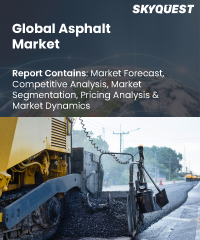
Report ID: SQMIG15F2085

Report ID:
SQMIG15F2085 |
Region:
Global |
Published Date: December, 2024
Pages:
157
|
Tables:
90 |
Figures:
77
The largest share in the global asphalt market was held by the Asia Pacific due to growing construction sector. The increased demand from emerging markets like South Korea, China, and India is responsible for this expansion. Due to the region's growing urbanization and population, China is also the main customer. Regional market expansion is anticipated to be aided by significant infrastructure expansion, construction sector innovation, industry consolidations, and economic growth in the area. The building sector is preparing for slower economic development due to a rise in the coronavirus in the Asia Pacific region. For example, the Indian government set out Rs. 60,241 crores (US$ 8.28 billion) for road construction and Rs. 57,350 crores (US$ 7.88 billion) for national highways in the Union Budget 2021. By March 2022, the government intends to have 8,500 kilometers of road built. Furthermore, by March 2022, 11,000 km more of the National Highway routes will be finished. The Ministry of Road Transport and Highways would receive an investment of Rs. 118,101 crores (US$ 16.20 billion), according to the government. Additionally, the government received a project under the Bharatmala Pariyojana costing Rs. 5.35 lakh crore (US$ 73.37 billion), which included building more than 13,000 km of roads for Rs. 3.3 lakh crore (US$ 45.26 billion).
The global asphalt market in North America is anticipated to expand during the forecast period as a result of the region's expanding use of residential structures for recreational purposes and the expanding trend of maintaining roads and highways. Strong economic expansion, rising building activity, supportive governmental policies, and increased consumer demand will all significantly increase supply. For example, the most recent estimates reveal that rules imposed by all levels of government account for 23.8 percent of the ultimate cost of a brand-new single-family house constructed for sale. In contrast to earlier research, surveying developers and builders separately resulted in a slightly different breakdown of the cost of regulation, with 10.5 percent of the final home price attributable to regulation during the development of the lot and the remaining 13.3 percent attributable to regulation during the construction of the single-family structure. The 23.8 percent prediction for 2021 is a modest decrease from the 24.3 percent seen in a prior research.
Our industry expert will work with you to provide you with customized data in a short amount of time.
REQUEST FREE CUSTOMIZATIONWant to customize this report? This report can be personalized according to your needs. Our analysts and industry experts will work directly with you to understand your requirements and provide you with customized data in a short amount of time. We offer $1000 worth of FREE customization at the time of purchase.

Report ID: SQMIG15F2085